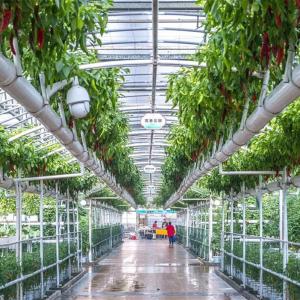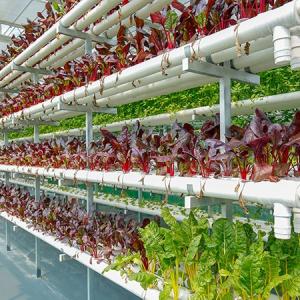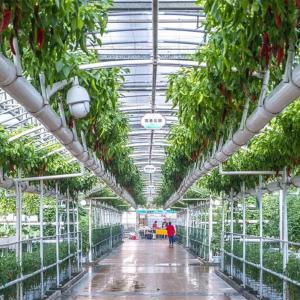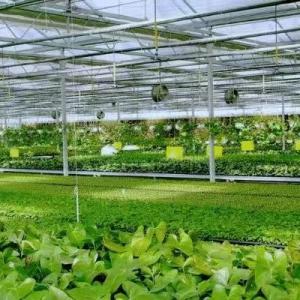Decoding High-End Dutch Glass Greenhouses: Core Design Logic and Advantages in Construction
In the field of modern agriculture, high-end Dutch glass greenhouses, typified by aluminum alloy gutters, have become the preferred solution for large-scale solanaceous vegetable cultivation due to their scientific design concepts and advanced construction technologies. Far from being a simple combination of "glass + steel frames", these greenhouses embody a systematic design philosophy that balances durability, efficiency, and ecological sustainability, with their core advantages manifested in the following six dimensions.
1. Robust and Weather-Resistant Structural System: Laying a Foundation for Long-Term Operation
Dutch glass greenhouses adopt high-strength steel frames as their core load-bearing structure, achieving a perfect balance between "lightweight structure and super load-bearing capacity". The frame materials undergo dual-process treatment of hot-dip galvanizing and plastic coating, which not only effectively resists corrosion in the high-humidity, foggy special environment of greenhouses but also ensures a service life of over 30 years. Some greenhouses with standardized maintenance can even exceed 40 years of service, providing growers with a long-term and stable production carrier while significantly reducing repeated construction costs.
2. Optimized Light and Heat Design: Empowering Efficient Crop Growth
To meet the photosynthesis needs of crops, the top of the greenhouse is covered with high-transmittance diffuse reflection special glass. This type of glass not only increases the utilization rate of natural light to over 90% but also avoids crop leaf burn caused by strong light through the diffuse reflection effect, resulting in more uniform light distribution indoors. Combined with the sealed design of double-layer insulating glass and broken-bridge aluminum profiles, its thermal insulation performance in winter is 40% higher than that of traditional greenhouses. Even in low-temperature environments of -10℃, it can maintain a suitable growth temperature of 15-25℃ without over-reliance on heating equipment.
3. Full-Process Automated Control: Freeing Up Labor Costs
Relying on a modular automated control system, Dutch glass greenhouses realize "unmanned operation" in environmental regulation. The system can automatically complete operations such as the retraction and deployment of sunshade nets, the opening and closing of top and side windows, and the start and stop of water curtain fans according to preset parameters, accurately regulating key indicators such as temperature, humidity, and carbon dioxide concentration in the greenhouse. Taking a 10,000-square-meter greenhouse as an example, only 2-3 managers are needed for daily operation and maintenance, saving 80% of labor costs compared with traditional greenhouses.
4. Intelligent Management System: Enabling Precision Cultivation
The in-depth integration of the Internet of Things, big data, and artificial intelligence technologies has built an intelligent management closed loop of "perception-analysis-decision". Various sensors installed in crop roots, leaves, and growth environments collect growth data and environmental data every 5 minutes. After being analyzed by the cloud platform, these data automatically generate precise management plans for irrigation, fertilization, and pest control, guiding growers in scientific operations and avoiding errors caused by empirical cultivation.
5. Resource Recycling: Practicing the Concept of Ecological Cultivation
In terms of resource utilization, Dutch glass greenhouses have built a full-chain recycling system. The integrated water and fertilizer equipment delivers water and nutrients directly to crop roots through drip irrigation technology. Combined with rainwater collection and sewage purification systems, the water resource utilization rate reaches more than 95%, reducing water consumption by 70% compared with traditional cultivation. In terms of land use, multi-layer vertical hydroponics and aeroponics models increase the unit area yield by 3-5 times compared with open-field cultivation. For fertilizers, the utilization rate is increased to 85% through humus recycling and precise proportioning technology, significantly reducing the amount of chemical fertilizers used.
6. Green Pest Control System: Ensuring Agricultural Product Safety
The stable and controllable closed environment fundamentally reduces the invasion routes of pests and diseases. Combined with physical control methods such as insect-proof nets and yellow sticky traps, the incidence of pests and diseases can be reduced by 60%. For occasional pests and diseases, biological control technologies such as natural enemy insects and biological pesticides are prioritized to replace traditional chemical pesticides, resulting in agricultural products with pesticide residues far below national standards, which not only ensures food safety but also reduces pollution to the ecological environment.
From structural design to technological application, the core logic of high-end Dutch glass greenhouses always revolves around the three goals of "quality improvement, efficiency enhancement, and ecological protection". This kind of cultivation carrier that integrates durability, efficiency, and sustainability is becoming an important direction for the transformation and upgrading of modern agriculture.





